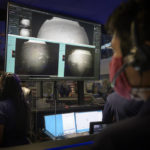A group of engineers working at ICAO are taking a crowd-thinking approach to saving lives in urban areas.
The team, along with aviation enthusiasts, students and companies are looking at solutions for the development of an urban air vehicle to take on the role of the air ambulance, which can operate in tight urban environments.
Yuri Fattah and his team of eager volunteers decided to look at an aircraft that could get to places where today’s helicopters might not – one that could be a cost effective option for emergency services around the world. But they knew they needed more help.
ICAO engineer Yuri Fattah explains: “We were working with Charles Bombardier at ICAO, where he had given some speeches on the future of aviation. And we realised the meaning there. About three of us on the team realised quite quickly that we could reconnect with our love for aviation.”
With numerous flying car innovations starting to come online, Fattah said that the industry had moved “the centre of gravity of design,” making it much more affordable to participate in.
Aircraft designed using free software
Fattah explained: “We downloaded free software, where people can just design their own aircraft. And we had a couple of those that we did in our spare time working with Charles’ outfit. And because they provided advice on, if you want to explain to the world why you’re doing something, or why new concept is useful, you have to put it in context of its use not so much in, in its engineering, right, as people are much more excited about the use case, they are about, you know, newly designed type of wing. So we did that.”
The coalition across a connected worldwide community began and the result is Ambular. Groups around the world are now giving their time and experience freely to literally get this idea off the ground. “We just wanted to take the next step from lifting that Idea off the page into something that people can touch and feel and experience,” said Fattah.
The team has worked in a virtual reality environment to experience what it might be like to fly through a modern future city in the Ambular.
“Our urban mobility concept would require the user, in this case, the healthcare the doctor, or whoever is requesting transport of the patient, they would provide the system with that information, and the system would then figure out the most efficient, and manage to meet that performance requirement, which is to save the life or to transport the patient. It’s not only for life saving, it will respond to the other inputs for the other variables, and can use the ambulance as part of that transport solution.”
Design stage likely to be complete in three years
The Ambular team said it was unlikely that any commercial developers of urban air equipment would be focusing on such a potentially small market – albeit an important one for society – at this stage, which is why they are focused on bringing the project forward – with no financial gain expected.
The team will iterate through testing and redesigning about four or five times, with each cycle taking about six to nine months before we Ambular 3.0 is finalised.
“That’s probably earliest going to be in about three years’ time. And then our focus is going to shift to building a quarter scale flying prototype a fully functional one. And we will probably, I would say, that’s about five to six years from now. The idea is to close the project at that stage. Because we think that then we’ve hopefully provided enough information and knowledge back to the community.”
“We don’t foresee taking it to a full scale prototype, because in a full scale prototype scenario, I think the value of doing this as a community driven idea is not going to be able to lead won’t make any sense. There’ll be too many people who are solving problems, that they’re not going to be comfortable sharing the solutions with others.”
Get involved – find out more at Ambular – Saving Critical Minutes

